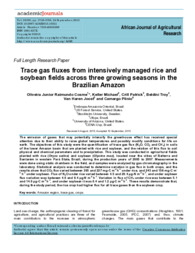Trace gas fluxes from intensively managed rice and soybean fields across three growing seasons in the Brazilian Amazon.
Trace gas fluxes from intensively managed rice and soybean fields across three growing seasons in the Brazilian Amazon.
Author(s): OLIVEIRA JUNIOR, R. C.; KELLER, M.; CRILL, P.; BELDINI, T.; HAREN, J. van; CAMARGO, P.
Summary: The emission of gases that may potentially intensify the greenhouse effect has received special attention due to their ability to raise global temperatures and possibly modify conditions for life on earth. The objectives of this study were the quantification of trace gas flux (N2O, CO2 and CH4) in soils of the lower Amazon basin that are planted with rice and soybean, and the relation of this flux to soil physical and chemical parameters and to precipitation. This study was conducted in agricultural fields planted with rice (Oryza sativa) and soybean (Glycine max), located near the cities of Belterra and Santarém in western Pará State, Brazil, during the production years of 2005 to 2007. Measurements were done using static chambers in the field, and samples were analyzed by gas chromatography in the laboratory. Statistical analysis was conducted to determine variation in gas flux in both crops, and the results show that CO2 flux varied between 305 and 227 mg-C m-2 h-1 under rice, and 243 and 156 mg-C m-2 h-1 under soybean. Flux of N2O under rice varied between 4.5 and 20.4 μg-N m-2 h-1, and under soybean flux variation was between 4.0 and 9.4 μg-N m-2 h-1. Variation in flux of CH4 under rice was between 5.1 and 14.0 μg-C m-2 h-1, and under soybean it was 0.4 and 1.2 μg-C m-2 h-1. These results demonstrate that, during the study period, the rice crop had higher flux for all trace gases than the soybean crop.
Publication year: 2015
Types of publication: Journal article
Unit: Embrapa Eastern Amazon
Observation
Some of Embrapa's publications are published as ePub files. To read them, use or download one of the following free software options to your computer or mobile device. Android: Google Play Books; IOS: iBooks; Windows and Linux: Calibre.
Access other publications
Access the Agricultural Research Database (BDPA) to consult Embrapa's full library collection and records.
Visit Embrapa Bookstore to purchase books and other publications sold by Embrapa.

